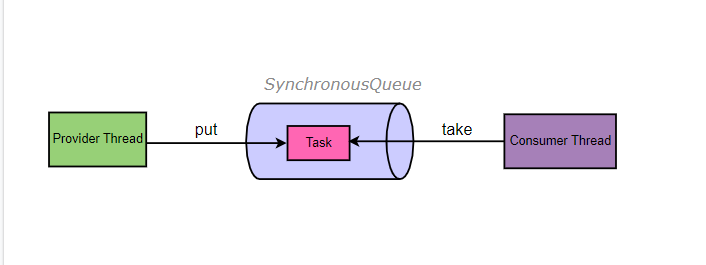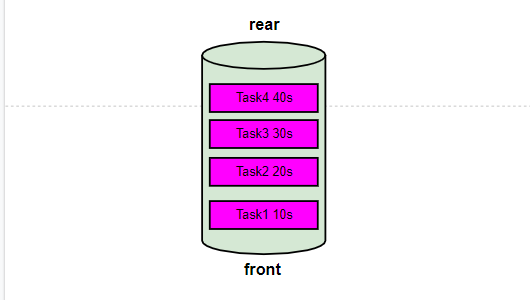
采用数组来实现,并采用可重入锁ReentrantLock来做并发控制,无论是添加还是读取,都先要获得锁才能进行操作 可看出进行读写操作都使用了ReentrantLock,ArrayBlockingQueue需要为其指定容量
public boolean offer(E e) {
checkNotNull(e);
final ReentrantLock lock = this.lock;
lock.lock();
try {
if (count == items.length)
return false;
else {
enqueue(e);
return true;
}
} finally {
lock.unlock();
}
}
public void put(E e) throws InterruptedException {
checkNotNull(e);
final ReentrantLock lock = this.lock;
lock.lockInterruptibly();
try {
while (count == items.length)
notFull.await();
enqueue(e);
} finally {
lock.unlock();
}
}
由于SynchronousQueue源码比较复杂,里面大量的Cas操作,SynchronousQueue没有容器,所以里面是装不了任务的,当一个生产者线程生产一个任务的 时候,如果没有对应的消费者消费,那么该生产者会一直阻塞,知道有消费者消费为止。
图示:

如下代码,如果我们将消费者线程注释掉执行,那么生产者哪里将会一直阻塞
package thread.customthreadpool;
import java.util.concurrent.ExecutorService;
import java.util.concurrent.Executors;
import java.util.concurrent.SynchronousQueue;
import java.util.concurrent.ThreadPoolExecutor;
/**
* 测试SynchronousQueue
*/
public class SynchronousQueueTest {
private static final SynchronousQueue<String> synchronousQueue = new SynchronousQueue<>();
private static final ExecutorService service = Executors.newCachedThreadPool();
public static void main(String[] args) {
/**
* Provider
*/
service.submit(() -> {
try {
synchronousQueue.put("liu");
}catch (Exception e){
e.printStackTrace();
}
System.out.println("Consumer finished spending");
});
/**
* Consumer
*/
service.submit(() ->{
try {
synchronousQueue.take();
}catch (Exception e){
e.printStackTrace();
}
System.out.println("take over");
});
}
}
LinkedBlockingDeque是一个双向队列,底层使用单链表实现,任何一段都可进行元素的读写操作,在初始化LinkedBlockingDeque的时候, 我们可以指定容量,也可不指定,如果不指定,则容量为Integer.MAX_VALUE,
注:Deque是双端队列,而Queue是单端队列,双端意思是两端都可以进行读写操作,而单端则只能从一端进,一端出(FIFO)
public LinkedBlockingDeque() {
this(Integer.MAX_VALUE);
}
package thread.customthreadpool;
import java.util.concurrent.LinkedBlockingDeque;
public class LinkedBlockingDequeTest {
private static final LinkedBlockingDeque<Integer> deque = new LinkedBlockingDeque<>();
public static void main(String[] args) throws InterruptedException {
deque.put(1);
deque.put(2);
deque.put(3);
deque.put(4);
deque.put(5);
System.out.println(deque);
System.out.println("deque size "+deque.size());
deque.take();
deque.take();
deque.take();
deque.take();
deque.take();
System.out.println(deque);
System.out.println("deque size "+deque.size());
}
}

底层基于单向连表实现,是一个单向队列,具有先进先出(FIFO)特点,使用了ReentrantLock来做并发控制,读写操作都上锁
private final ReentrantLock putLock = new ReentrantLock();
public void put(E e) throws InterruptedException {
if (e == null) throw new NullPointerException();
int c = -1;
Node<E> node = new Node<E>(e);
final ReentrantLock putLock = this.putLock;
final AtomicInteger count = this.count;
putLock.lockInterruptibly();
try {
while (count.get() == capacity) {
notFull.await();
}
enqueue(node);
c = count.getAndIncrement();
if (c + 1 < capacity)
notFull.signal();
} finally {
putLock.unlock();
}
if (c == 0)
signalNotEmpty();
}
public E take() throws InterruptedException {
E x;
int c = -1;
final AtomicInteger count = this.count;
final ReentrantLock takeLock = this.takeLock;
takeLock.lockInterruptibly();
try {
while (count.get() == 0) {
notEmpty.await();
}
x = dequeue();
c = count.getAndDecrement();
if (c > 1)
notEmpty.signal();
} finally {
takeLock.unlock();
}
if (c == capacity)
signalNotFull();
return x;
}
DelayDeque是一个无界队列,添加进DelayDeque的元素会经过compareTo方法计算,然后按照时间 进行排序,排在队头的元素是最早到期的,越往后到期时间越长,DelayDeque只能接受Delayed接口类型 如图所示,队列里的元素并不是按照先进先出的规则,而是按照过期时间

示例
package thread.customthreadpool.delayDeque;
import java.util.concurrent.Delayed;
import java.util.concurrent.TimeUnit;
public class MyDelayed implements Delayed {
private final String taskName ;
private final long nowTime = System.currentTimeMillis();
private final long expireTime ;
public MyDelayed(String taskName,long expireTime) {
this.taskName = taskName;
this.expireTime = expireTime;
}
@Override
public long getDelay(TimeUnit unit) {
return unit.convert((nowTime+expireTime) - System.currentTimeMillis(),TimeUnit.MILLISECONDS);
}
@Override
public int compareTo(Delayed o) {
MyDelayed myDelayed = (MyDelayed) o;
return (int) (this.getDelay(TimeUnit.MILLISECONDS) - o.getDelay(TimeUnit.MILLISECONDS));
}
@Override
public String toString() {
return "MyDelayed{" +
"taskName='" + taskName + '\'' +
", nowTime=" + nowTime +
", expireTime=" + expireTime +
'}';
}
}
package thread.customthreadpool.delayDeque;
import java.util.concurrent.*;
public class MyDelayQueue {
private static final DelayQueue<MyDelayed> delayQueue = new DelayQueue<>();
private static final ExecutorService service = Executors.newCachedThreadPool();
public static void main(String[] args) throws InterruptedException {
service.submit(() -> {
delayQueue.put(new MyDelayed("A-Task",5000));
delayQueue.put(new MyDelayed("B-Task",4000));
delayQueue.put(new MyDelayed("C-Task",3000));
delayQueue.put(new MyDelayed("D-Task",2000));
delayQueue.put(new MyDelayed("E-Task",1000));
});
while (true){
System.out.println(delayQueue.take());
}
}
}
result

应用场景
1.美团外卖订单:当我们下单后没付款 ,30分钟后将自动取消订单
2.缓存,对于某些任务,需要在特定的时间清理;
and so on
当消费线程从队列中取元素时,如果队列为空,那么生成一个为null的节点,消费者线程就一直等待,此时如果生产者线程发现队列中有一个null节点, 它就不入队了,而是将元素填充到这个null节点并唤醒消费者线程,然后消费者线程取走元素。
LinkedTransferQueue是 SynchronousQueue 和 LinkedBlockingQueue 的整合,性能比较高,因为没有锁操作, SynchronousQueue不能存储元素,而LinkedTransferQueue能存储元素,
PriorityBlockingQueue是一个无界的阻塞队列,同时是一个支持优先级的队列,读写操作都是基于ReentrantLock, 内部使用堆算法保证每次出队都是优先级最高的元素
public E take() throws InterruptedException {
final ReentrantLock lock = this.lock;
lock.lockInterruptibly();
E result;
try {
while ( (result = dequeue()) == null)
notEmpty.await();
} finally {
lock.unlock();
}
return result;
}